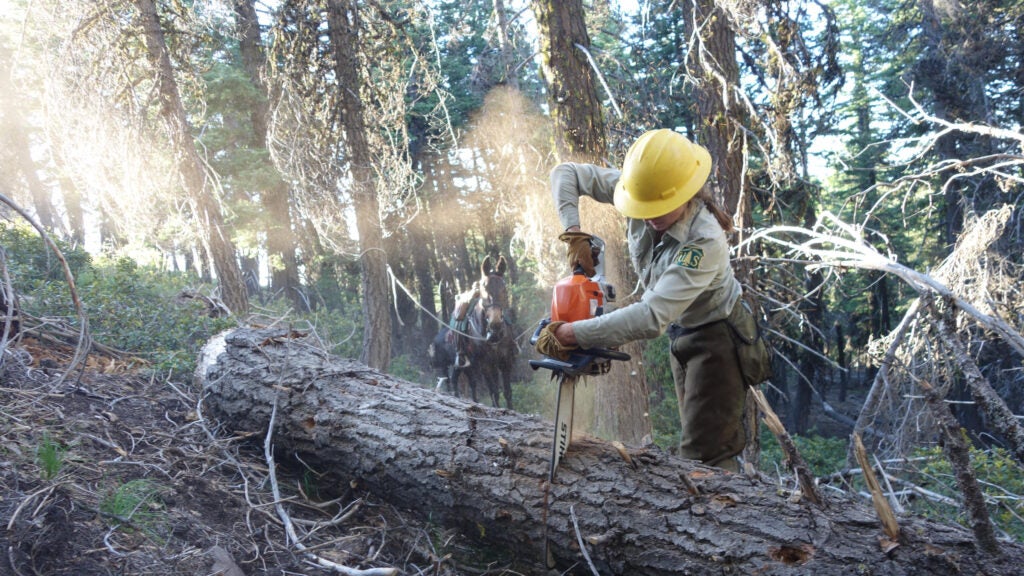Jobs
The Forest Service is Losing 2,400 Jobs—Including Most of its Trail Workers

“], “filter”: { “nextExceptions”: “img, blockquote, div”, “nextContainsExceptions”: “img, blockquote, a.btn, a.o-button”} }”>
Heading out the door? Read this article on the new Outside+ app available now on iOS devices for members!
>”,”name”:”in-content-cta”,”type”:”link”}}”>Download the app.
The U.S. Forest Service is a federal agency that manages 193 million acres of land, an area about the size of Texas. Next year, the agency will have to manage that land without its seasonal workforce. In September, the agency announced that it would be suspending all seasonal hiring for the 2025 season, a decision that will cut about 2,400 jobs. Nearly all of those positions are field-based jobs, ranging from biologists and timber workers to trail technicians and recreation staff. In addition, the agency is freezing all external hiring for permanent positions. The only exception to the hiring freeze are the roughly 11,300 firefighters hired by the agency every year.
According to the agency and its partners, the effects of these staffing cuts will be far-ranging and severe. In the September 17 all-employee call where he announced the hiring freeze, Forest Service Chief Randy Moore said “We just can’t get the same work done with fewer employees.” Though the Forest Service has been shedding jobs for decades—about 8,000 jobs in the last 20 years, Moore said—this will be the largest single-year staff cut in recent memory.
Seasonal employees perform vital fieldwork and research that extends beyond what many Americans consider the jurisdiction of the Forest Service. Rangers patrol whitewater rivers, rock climbing crags, and dangerous alpine summits. Biologists staff critical salmon fisheries. Recreation crews maintain forest roads and clean camp latrines. Employees of all types chip in as emergency firefighters when required. According to the American Avalanche Association, the staff cuts could leave some avalanche centers, which rely on the Forest Service for funding, understaffed this winter.
And then there are trails. According to the Government Accountability Office, the Forest Service has had a maintenance backlog for more than a decade, and oversees more miles of trail than it can maintain. Cutting the majority of its field-going trail staff will only make the issue worse.
“This policy will result in a burgeoning of the trail maintenance backlog, both through lack of Forest Service staff attention to trail maintenance, but also through the loss of connection and relationships with partner organizations,” Mike Passo, the executive director of American Trails, a non-profit Forest Service partner, said in an email.
Backpacker spoke to nearly a dozen permanent and seasonal Forest Service employees, most on condition of anonymity, about their experiences with the staffing cuts. Several expressed concern that trail crews would simply be unable to operate. They described crews of six seasonal employees disappearing, leaving one or two permanent crew leaders left trying to make things work. One intern in the National Pathways program, designed to automatically place successful interns into a full-time position with the agency, said she’s been told her job offer will likely be revoked. Other trail workers at conservation corps and non-profits who saw Forest Service positions as a step up the career ladder are rethinking their priorities.
Danica Mooney-Jones, a trail crew leader who’s been with the Forest Service since 2021, is among those out of a job next year. Where she works, the trail crew staff will go from five to two, and the broader recreation program is being cut from 13 employees to just four.
“I moved across the country to work here, for a seasonal job,” she says. “We have people who have worked here for 10 years as seasonals, and made a career out of these positions. They trusted that the jobs wouldn’t go away.”
Now, she and her former co-workers have a tough choice to make: leave their communities to find a job in trails somewhere else, or stay put and find a new career. Mooney Jones considers herself lucky; armed with wilderness EMT training, she found a local winter job as a ski patroller. Still, the idea of leaving the Forest Service behind for good is sobering.
“I’d be really sad if this was the end of my trail career,” says Mooney-Jones. “I really love doing the work, I love seeing the product, and I’m very proud of the work that we do.”
Trail maintenance is important every season, but 2025 may prove an especially difficult year to cut down on the workers who make it happen. After Hurricane Helene, southern portions of the Appalachian Trail are closed due to blowdowns, landslides, and washed out bridges. According to the Appalachian Trail Conservancy, there are more than 2,000 trees to clear from the AT in Tennessee alone, and many Forest Service access roads from Georgia to Virginia are closed due to erosion and rockfall.
That’s just on the AT—a popular long-distance trail supported by a non-profit organization and hundreds of trained volunteers. Elsewhere in the southern US, lesser-known trails face similar conditions but rely solely on Forest Service staff in order to re-open.
The cuts also left employees and partners wondering how the budget shortfall became so dire after several promising years of funding increases.
In 2021, the Biden administration mandated a $15 per hour minimum wage for all federal employees, which raised wages for some entry-level Forest Service jobs. Over the past several years, the agency also converted about 1,300 seasonal non-fire positions into permanent jobs. Wildland firefighters, who now make up about half of the Forest Service’s workforce, received bonuses of up to $20,000 per year, which were temporarily funded through the Bipartisan Infrastructure Act. Several Forest Service employees said there was hope that pay raises for firefighters would eventually translate into raises for other field-going employees, as well.
But those short-term gains have all but disappeared, replaced by a sudden budget shortfall.
In March, the Forest Service requested $8.9 billion in funding, a $500 million jump from 2024’s $8.37 billion. By the summer, it was clear the agency was unlikely to receive it. In August, Forest Service Chief Randy Moore released a statement preparing the USFS for a reduced budget. With little evidence that Congress would pass a bill funding the government by the end of the year, Moore said in the September 17 all-employee call that “[the Forest Service] has an obligation to plan for the most conservative funding possibility.” A week later, Congress passed a continuing resolution that extended the 2024 funding levels through December 20.
The lowest number Moore referred to comes from the proposal from the House Interior Appropriations Committee, which sets spending limits for all federal land management agencies, including the Forest Service and National Park Service. This year’s proposal includes $8.43 billion for the Forest Service—technically a modest increase compared to 2024. But last year’s budget was boosted by an additional $945 million through pandemic-era stimulus bills, a funding source that has since dried up. And while the House proposal fully funds the firefighter pay raises, the proposed budget would still necessitate cuts elsewhere at the agency. All of these details muddy the financial picture, but compared to total funding in 2024, the agency could face a budget hole of nearly a billion dollars next year.
Because the Forest Service’s budget for next year is still not finalized, there is a chance the agency will fill some seasonal positions in the near future. “We are working closely with individual partners to explore creative solutions to fill gaps where we can. And we hope to have more hiring options in the coming year if additional funding becomes available,” Scott Owen, national press officer for the Forest Service, wrote in an email.
Even with these sobering financial details, it’s clear that the agency’s decision to balance the books by cutting seasonal jobs came as a shock to many employees.
“My trust has definitely taken a hit,” says Mooney-Jones. “I’d consider coming back to the Forest Service, but I’m not sure I could. It’s a balancing act between how I feel about how we’ve been treated and how much I love the forest.”









